The Treasure of
the Sierra Madre {
1948 }
Director : John Huston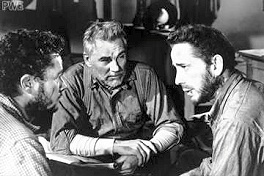
From the novel by B.Traven
It may be
true that Treasure
is fondly remembered among the older generation and
film buffs but there's no doubt whatsoever that it is virtually lost
to younger filmgoers who may be difficult to persuade that a film made
all of half a century ago has merit. In fact, apart from being an
excellent film with the theme that "The love of money is the root
of all evil" and a wonderfully atmospheric evocation of 1925
Tampico, Mexico, it is a fascinating slice of Hollywood history in so
many diverse ways. The story itself is straightforward but the manner
that it is related is chock full of classic movie vignettes ;
When John Huston takes the part of a well-heeled American in a walk-on
part and is accosted three times by a down-on-his-luck Dobbs { Bogart
} with the same line
"Hey
Mister, stake a fellow American to a meal ?"
it is both funny and poignant at the same time.
When
Fred.C. Dobbs { Bogart } reveals his true nature right at the
beginning of the film disgracefully throwing a glass of water over the
street urchin who by chance sells him the winning lottery ticket which
is the catalyst to the whole adventure.
Walter
Huston's little jig when he finds he is going on another quest for
gold.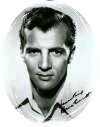
And of
course the classic "
Badges
! I don't need no steenkin' badges!"
by the Mexican bandit {Alphonso Bedoya }.
When
Curtin poignantly reads the letter from Codie's wife and his
expression says it all in revealing some future happiness in that
direction.
An
uncredited cameo by Ann Sheridan as a prostitute. And so many
others too many to recount.
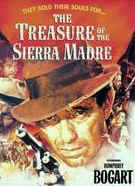 The
cast itself is as fascinating as the characters they play ; Humphrey
Bogart needs no introduction but Walter Huston who is of course John
Huston's dad was actually born in 1884 in Toronto. His film credits
are too long to recount here but he is just as famous for his other
role as the patriarch of the Huston dynasty. Tim Holt was originally
among the plethora of Saturday matinee cowboys, Roy Rogers, Hopalong,
Gene Autry and so on but if his performance as Curtin is anything to
go by he had talents far in excess of his usual mundane roles. Bruce
Bennett as Cody is the most interesting of all of them ---- born in
1906 he won a silver medal for the shot-putt in the 1928 Olympics and
was chosen by Edgar Rice Burroughs to play Tarzan in several films in
1935. At that time he was using the name of Herman Brix and starred in
a number of serials for Republic Pictures. Just like Tim Holt, Bennett
was a far better actor than he was given credit for and directors like
Huston must take the credit for bringing out those qualities. The
cast itself is as fascinating as the characters they play ; Humphrey
Bogart needs no introduction but Walter Huston who is of course John
Huston's dad was actually born in 1884 in Toronto. His film credits
are too long to recount here but he is just as famous for his other
role as the patriarch of the Huston dynasty. Tim Holt was originally
among the plethora of Saturday matinee cowboys, Roy Rogers, Hopalong,
Gene Autry and so on but if his performance as Curtin is anything to
go by he had talents far in excess of his usual mundane roles. Bruce
Bennett as Cody is the most interesting of all of them ---- born in
1906 he won a silver medal for the shot-putt in the 1928 Olympics and
was chosen by Edgar Rice Burroughs to play Tarzan in several films in
1935. At that time he was using the name of Herman Brix and starred in
a number of serials for Republic Pictures. Just like Tim Holt, Bennett
was a far better actor than he was given credit for and directors like
Huston must take the credit for bringing out those qualities.
Just to make things even more intriguing, the author of The Treasure
of The Sierra Madre is a complete mystery in himself. He went under so
many pseudonyms that nobody ever found out who he was ---- there was a
rumour that he met John Huston and was around the film set but nobody
could prove it and even today his identity is in doubt.
But the real Treasure of The Sierra Madre
went undiscovered for years
until Canadian naturalists diligently tracked it down. The Monarch
butterfly is one of the very few of the species to migrate and the
vast distances that it covered from Lower Canada to South America
caused much speculation as to where it over-wintered. The site is in a
remote valley in the Sierra Madre mountains where billions of the
butterflies hang in the trees in such great numbers that they have
been known to cause some of them to topple down.
A
Place in the Sun
{ 1951 }
Director ; George Stevens
From the novel An American Tragedy by Theodore Dreiser
The arguments still rage about the merits of Dreiser's writing and
there are those who see An American Tragedy, written in 1925, as a
critique upon Capitalism, but it deals more with the concomitants of
Capitalism, social-status and class-consciousness, rather than the
political structure itself. For some reason, at that particular
time and in that particular place { upper New York State } there was a
class snobbishness in place which was usually more attributable to the
English aristocracy. The social background is fundamental to
both the film and the novel which is based upon a real life murder in
1906 in New York.
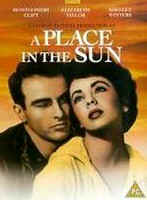 The
plot centres around the essentially weak and self-pitying persona of
George Eastman, played by the 29 year old Montgomery Clift.
George's ambitions are matched only by his ineptitude and having been
given a post on the shop floor of his Uncle's manufacturing factory he
manifests little flair or aptitude for even that lowly job. He
takes up with Alice, a factory girl with no pretensions or ambitions
to be anything else. Alice is played by Shelley Winters who was
stunningly beautiful in her younger days and light years way from
"the swimmer" that she so detested being remembered for in Poseidon. However, Stevens chose to portray her character as
drab and frumpy and not too bright with it which is hardly
complimentary to factory girls in general ----- most of the ones I
ever knew wore their working gear by day and looked like they had been
sprinkled with stardust by night. Be that as it may. Alice falls
for George's good looks and providing a shoulder for him to cry on
they enter into a mutually supportive relationship. The
plot centres around the essentially weak and self-pitying persona of
George Eastman, played by the 29 year old Montgomery Clift.
George's ambitions are matched only by his ineptitude and having been
given a post on the shop floor of his Uncle's manufacturing factory he
manifests little flair or aptitude for even that lowly job. He
takes up with Alice, a factory girl with no pretensions or ambitions
to be anything else. Alice is played by Shelley Winters who was
stunningly beautiful in her younger days and light years way from
"the swimmer" that she so detested being remembered for in Poseidon. However, Stevens chose to portray her character as
drab and frumpy and not too bright with it which is hardly
complimentary to factory girls in general ----- most of the ones I
ever knew wore their working gear by day and looked like they had been
sprinkled with stardust by night. Be that as it may. Alice falls
for George's good looks and providing a shoulder for him to cry on
they enter into a mutually supportive relationship.
Despite his lowly position in the factory, George's benefactor is
reluctantly persuaded into bringing him into the penumbra of their
social sphere where the vivacious Angela Vickers { 18 years old Liz
Taylor } is also taken with his good looks and blarney. Their
liaison which is at first frivolous
gradually grows into a passionate love affair and with marriage in the
offing George finally finds himself with the opportunity to possess
the wealth and status that he has always aspired to.
On the cusp
of achieving The American Dream, George's world is shattered when
Alice reveals that she is pregnant and fully expects him to honour his
commitment by marrying her.
In an age when illegitimacy was frowned upon, George could think of
only one solution to his problems and it was one which brought the
whole house of cards crashing down.
Theodore Dreiser's novels are virtually unknown in the U.K. which is
strange as they have all the elements of good social drama -- made in
black and white, George Stevens's interpretation of An American
Tragedy makes a great film which is also mysteriously little
known. Stevens went on to make Shane the following year.
Elmer
Gantry { 1960
Director : Richard Brooks
From the novel by Sinclair Lewis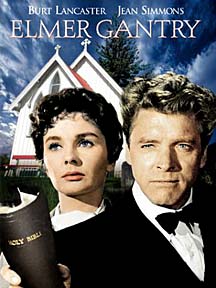
Circa
the 1920's Sinclair Lewis was feted for his perceptive novels about
small-town U.S.A. and the morals and mores of their
inhabitants. He took the Nobel Prize for Literature for Dodsworth much
to the chagrin of Theodore Dreiser but for what it's
worth in my opinion Elmer Gantry is his finest work.
When the name Richard Brooks is mentioned it hardly brings to mind
visions of a top-class film Director, if indeed it brings to mind
anyone at all. But top-class Director is what he was with films such
as Lord
Jim, Cat
on a Hot Tin Roof,
and The Professionals
among
others credited to him throughout the 50's and 60's. Largely forgotten
now, The
Blackboard Jungle
with Glenn Ford as a besieged teacher in an inner city school was
arguably his finest work and is as relevant now as it was then.
Brooks' translation of Sinclair Lewis's novel onto the screen is the
work of a craftsman and the result is a thoughtful and entertaining
film which easily passes the litmus test of being as fresh today as
the day it was released.
Burt Lancaster as Elmer Gantry positively demands our attention with a
dynamic virtuoso performance which switches abruptly from hyperactive
flamboyance to hell and damnation oratory through flashing smiles and
bonhomie and onto a charm and sincerity that would make the angels
weep. It's a roller-coaster ride through a range of emotions expressed
by an actor at the height of his powers. It's the Crimson Pirate meets
Billy Graham and it's brilliant! But don't just take my word for
it ----- Hollywood thought so too and awarded him an Oscar to prove
it.
When we first encounter Elmer he is an unsuccessful travelling
salesman punctuating his attempts at selling with bouts of drinking
and womanising. Quite by chance he comes across a Revivalist meeting
where two things catch his attention ----- the first is the
realization that there is money to be made and the second is the
alluring but virginal Sister Sharon Falconer
{ Jean Simmons }. The
self-styled Sister Sharon carries her piety and humility around with
her like a cloak, serving only to pique Elmer's lust even more.
Ingratiating himself with the Revivalists, Elmer finds that he has the
power to hold an audience in the palm of his hand and revels in the
theatrics of his new role. Fire and Brimstone style speeches
interspersed with rousing Christian militaristic hymns culminating in
the soothing presence of Sister Sharon make great theatre and the
begging bowls are always brimming over.
There is an outstandingly hilarious scene when Elmer first takes to
the podium and after a rousing speech the silence is deafening. A man
leaps from the audience and races along the aisle taking his coat off
as he goes. Elmer immediately squares up the man before he realizes
that he is asking for Redemption. He never looks back after that and
Elmer has found his true vocation.
Burt Lancaster's presence in
Elmer Gantry
is all-encompassing but the
rest of the cast complement his performance as if they are aware that
this is his finest hour. Jean Simmons is so pure that she makes you
sick until it turns out that she is plain Katie from nowheresville and
was brought up in abject poverty, explaining her affinity for the
money. But nothing is as it seems in
Elmer Gantry
and Sister Falconer
intoxicated with her own success begins to believe in her own
divinity.
Arthur Kennedy plays Jim Lefferts a newspaper reporter who follows the
proceedings with a wry smile. Underplaying his role with his usual
restraint, Kennedy's reporter is a fine foil for the boisterous Gantry
and the two of them have some great dialogue and repartee reminiscent
of Inherit
the Wind.
There are some very clever theological arguments which are spoken with
machine-gun rapidity and make no concession to the listener but if you
can catch them they are well worth listening to with subtleties and
nuances unusual for any film. One particular argument which goes to
and fro ends with Gantry accusing Lefferts of being
" just
like Mencken, Ingersoll, Sinclair Lewis and all the other
atheists".
There are some surprising twists and turns at the end of the film and
all of the characters turn out to be multi-layered with unexpected
strengths and weaknesses. Shirley Jones as the feckless
prostitute, Lulu, turns in a fine performance making her character far
more than the stock "tart-with-a-heart" and it is implied
but not stated that Gantry is responsible for the situation she finds
herself in.
Sinclair Lewis took the subject of Evangelism and highlighted the
hypocrisy and cant of the Revivalists, the frenzied, rock-concert
atmosphere and the gullibility of the patrons. Written in 1927, his
novel was almost prophetic in its accuracy when Jimmy Swaggart et al
played out the very same roles in real life 30 years later.
A great movie produced from a great novel, seriously excellent acting,
thought-provoking dialogue and a great cast all within a morality tale
which still stands --- special effects are superfluous in films this
good.
Billy
Budd { 1962 }
Director : Peter Ustinov
From the novel by Herman Melville
Billy
Budd the stage play is a favourite of audiences everywhere and can
usually be found playing somewhere around the country. In contrast,
Billy Budd
the film has faded so much into obscurity that it is
difficult to obtain a copy. It is a given that 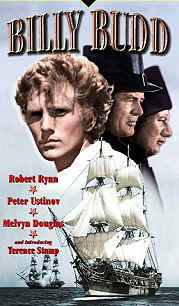 cinema
audiences are no less knowledgeable than theatre audiences so why this
should be so is a mystery particularly in view of the fact that it is
a great little movie and completely faithful to its origins. cinema
audiences are no less knowledgeable than theatre audiences so why this
should be so is a mystery particularly in view of the fact that it is
a great little movie and completely faithful to its origins.
Written in 1856, Melville's sea story is set in 1797 to a background
of the French Revolution, sending shock-waves throughout Europe and
the previously unthinkable occurrences of British seamen mutinying in
port. These two events are to have a devastating effect on the fate of
Melville's hero Billy, The Handsome Seaman, played to perfection by
Terence Stamp. The term Handsome Seaman was in common usage at the
time and did not carry the connotations that it would have today
---just the opposite in fact, with a Handsome Seaman regarded by his
fellow crewmen as an excellent seaman, strong, athletic and brave and
altogether a man among men.
When Billy is transferred to a new ship he immediately becomes a
favourite among his crew mates and at the same time the object of the
ire of the Master-of Arms, Claggart, played by Robert Ryan, who rides
him unmercifully. It is a deliberate irony that the name of the ship
is The Rights of Man.
Whenever Billy comes under stress he develops a stammer and in the
pivotal part of the film, unable to respond to Claggart's unjust
accusations he lashes out in frustration and inadvertently kills the
officer. Billy's trial and ultimate fate are determined by Captain
Vere { Peter Ustinov } with the aforementioned political situation
playing a great part in his decision.
On the face of it, Melville's story is quite straightforward but
looked at in depth it is more complex and explores the nature of
jealousy, hatred, envy and good and evil and not least how punishment
is sometimes unjust in order to satisfy the greater good.
A measure of just how much of an impact this film can deliver is that
I have never seen Billy Budd for more years than I care to remember
and all of the above is drawn from memory.
Is
Paris Burning ? {
1966 }
Director : René Clément
Larry Collins's and Dominique LaPierre's
book of the same name is a documentary of the liberation of Paris
which reads like a novel. The two authors collaborations have
the knack of bringing history to life and all of their books are
extremely exciting page-turners which educate and entertain in a
unique style all of their own ; City
of Angels was an evocation of poverty
in India and Or I'll Dress You in
Mourning told the story of the
bullfighting legend Manolito { Tom Jones was due to star in a musical
version but the idea fizzled out leaving only the flagship song The
Boy From Nowhere } and Is Paris
Burning ?
is possibly the best of all their books.
The film version makes a brave attempt to reproduce the excitement and
tension of the book but despite a staggering cast of truly biblical
proportions the film falls short and in a way it's the very numbers of
stars which overwhelm the film. The 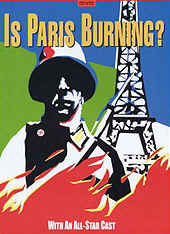 star-spotting
is so pervasive that it detracts from the action and even worse is
that very few of the stellar cast of actresses and actors have long
enough on screen to exhibit their skills ---- Simone Signoret is
miscast as a barmaid but you could miss her if you blink, Kirk
Douglas's Patton is the same and Glenn Ford as Omar Bradley has just
enough time to salute and so it goes on. Robert Stack. Anthony
Perkins, Gert Frobe and so many other favourites are all wasted in a
positive celebration of casting gluttony. star-spotting
is so pervasive that it detracts from the action and even worse is
that very few of the stellar cast of actresses and actors have long
enough on screen to exhibit their skills ---- Simone Signoret is
miscast as a barmaid but you could miss her if you blink, Kirk
Douglas's Patton is the same and Glenn Ford as Omar Bradley has just
enough time to salute and so it goes on. Robert Stack. Anthony
Perkins, Gert Frobe and so many other favourites are all wasted in a
positive celebration of casting gluttony.
Why there were so many a-list stars present is a mystery because in
truth the film is not character driven and is never about the quality
of acting ---the true star of the film is the city of Paris itself
around which most of the action revolves. The black and white
film and the street-fighting scenes blend in well with the archive
material giving the film an inescapable documentary quality. The
streets of Paris are completely empty as the action takes place which
is incredible in itself given the density of population and tourists
at all times and such are the numerous shots of Paris streets that in
time this film could be a valuable historic record if nothing
else.
Despite the presence of Gore Vidal and Francis Ford Coppola as
screenwriters the film is nowhere near as gripping as he book and
underplays the importance of Von Choltiz's role in history.
Nevertheless, despite all its faults the film does bring a major
historical event to life and puts flesh on the bones of all those
plaques dotted around Paris denoting the place of a fallen freedom
fighter.
The
Duellists {
1977 }
Director : Ridley Scott
Ridley Scott proved to be a class act right
from the word go, winning the Best Debut Film award at Cannes for his
very first effort at directing. Based on a Joseph Conrad story
called The Duel the film had Hollywood stars Keith Carradine and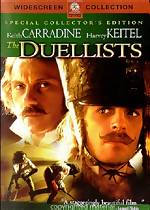 Harvey Keitel in the unusual roles of French officers during the
Napoleonic wars. Keitel as the rabid Bonapartist Feraud is
notoriously touchy and can be antagonised by anything that he
perceives as a slight upon himself or his idol Napoleon, no matter how
trivial, and the opening scenes show him dispatching a fellow officer
with ruthless efficiency. Feraud is humourless, volatile and
dangerous and a man without a single shred
of compassion. Keith
Carradine as the easy-going D'Hubert inadvertently falls foul of
Feraud's capacity for illogical anger and cannot believe that a chance
remark should prompt such an extreme reaction and he tries to dissuade
Feraud from duelling with him. Feraud cannot be reasoned with
and D'Hubert is unwillingly forced into the first of many duels with
Feraud. The two protagonists are well- matched and there is
never a conclusion to satisfy Feraud whose perverted sense of honour
demands that D'Hubert must die.
Harvey Keitel in the unusual roles of French officers during the
Napoleonic wars. Keitel as the rabid Bonapartist Feraud is
notoriously touchy and can be antagonised by anything that he
perceives as a slight upon himself or his idol Napoleon, no matter how
trivial, and the opening scenes show him dispatching a fellow officer
with ruthless efficiency. Feraud is humourless, volatile and
dangerous and a man without a single shred
of compassion. Keith
Carradine as the easy-going D'Hubert inadvertently falls foul of
Feraud's capacity for illogical anger and cannot believe that a chance
remark should prompt such an extreme reaction and he tries to dissuade
Feraud from duelling with him. Feraud cannot be reasoned with
and D'Hubert is unwillingly forced into the first of many duels with
Feraud. The two protagonists are well- matched and there is
never a conclusion to satisfy Feraud whose perverted sense of honour
demands that D'Hubert must die.
The careers of the two officers follow the course of the Napoleonic
wars and occasionally diverge to the great relief of D'Hubert who is
weary of the constant demands upon his honour by his relentless
nemesis. On the occasions when they meet Feraud inevitably
demands satisfaction and D'Hubert is forced to fight over and over
again until in the concluding duel D'Hubert gets the upper hand and
has Feraud at his mercy refusing to kill him despite Feraud's demands
to do so. D'Hubert spares Feraud with the words ; "
I have submitted to your notions of honour long enough, You will
now submit to mine"
I am very wary of attributing allegorical
undercurrents to any film for the simple reason that they can so
easily be just figments of the imagination. Not only that I have seen
films with allegorical sub-plots which make very little sense {
Poseidon comes to mind } and there is no mention of any allegory in
The Duellists. However, In the Duellists
everything points to
the inescapable assumption that the duels are allegories of Napoleon's battles with nations that he has
forced to fight and his belligerence across the battlefields of
Europe. D'Hubert's reluctance to fight and eventual wearying of
duels are parodies of a war-weary Europe finally overcoming
Napoleon. The final scene of Feraud with his back to us gazing
out across the landscape copies faithfully the sketches of Napoleon on
St.Helena.
The allegorical nature of the film is my assertion and is not proven at
all but what is true is that Scott's story is based upon a real-life
series of events in Napoleonic times when a Captain Dupont and a Captain
Fournier fought an incredible 17 duels over a period of 19 years. The duels are
more or less as Scott tells it. Joseph Conrad also found the story
intriguing and was inspired to write a short story called appropriately
The Duel on which the film draws much
of its material.
Even if you can't be bothered with the allegories this is still a very fine
film and captures perfectly the aura surrounding Napoleon and
the dog-like devotion it inspired in many of his followers. And
above all else there is some nerve-tingling swordplay.
Thief
{ 1981 }
Director : Michael Mann
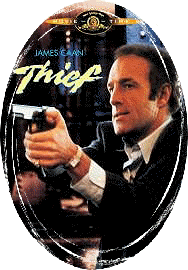 Just
like its anti-hero, Frank { James Caan }, Thief
is a taut, tense and
tough movie. Set in a cold and rainy Chicago, it is film
noir revisited as ex-con Frank tries to break free from his life of
crime by funding it via the eponymous "last job". The
problem is that Frank is a master cracksman and his skills are in
demand by a crime syndicate. At the same time he is beset by
corrupt cops demanding their share of the takings -- Frank inhabits a
dismal and depressing world of crooked cops and crooked crooks.
He dreams of a life in suburbia with his new wife, Jessie { Tuesday
Weld } but is constantly sucked down into the netherworld he has
inhabited for so many years. Battered by the police and betrayed
by the syndicate, Frank's method of breaking free from his past
is more than interesting and less than conventional. Just
like its anti-hero, Frank { James Caan }, Thief
is a taut, tense and
tough movie. Set in a cold and rainy Chicago, it is film
noir revisited as ex-con Frank tries to break free from his life of
crime by funding it via the eponymous "last job". The
problem is that Frank is a master cracksman and his skills are in
demand by a crime syndicate. At the same time he is beset by
corrupt cops demanding their share of the takings -- Frank inhabits a
dismal and depressing world of crooked cops and crooked crooks.
He dreams of a life in suburbia with his new wife, Jessie { Tuesday
Weld } but is constantly sucked down into the netherworld he has
inhabited for so many years. Battered by the police and betrayed
by the syndicate, Frank's method of breaking free from his past
is more than interesting and less than conventional.
James Belushi has little to say in his debut outing but that
indefinable "presence" which all stars have, draws you to
him whenever he is on screen. Tuesday Weld made her debut 25
years earlier { Rock, Rock, Rock
1956
} preceding Debbie Harry by a generation as every schoolboys
dream. It's just a shame that her career has never included any
major roles as judging by this performance she has been
under-performing for most of the time. Robert Prosky as Leo, the
head of the syndicate, is living proof of the banality of evil,
switching from syrupy father-figure with a touch of Fagin to vicious
overlord at the touch of a trigger. Great example of nouveau noir, largely overshadowed by Michael Mann's
later achievements.

On
Golden Pond (
1981 )
Director : Mark Rydell
When the irascible Norma Thayer and the
indomitable Ethel Thayer come together in their lodge on Golden Pond
there can only be one result ---- an Oscar for Henry Fonda as Norman and
an Oscar for Katharine Hepburn as Ethel. The two vintage Hollywood
icons have both matured like fine wine and the chemistry between them is
palpable as they play an old married couple, still very much in love as
they approach the twilight of their lives. The dialogue and the
situations they both find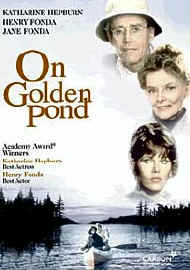 themselves in affirms the adage that old age
is not for wimps and says it all about the aging process as Norman finds
himself afraid as he walks alone in the woods and Ethel soothes
him like a child. themselves in affirms the adage that old age
is not for wimps and says it all about the aging process as Norman finds
himself afraid as he walks alone in the woods and Ethel soothes
him like a child.
From the time that his daughter Chelsea ( Jane Fonda ) arrives with her
fiance
( Dabney Coleman ) and his son Billy played superbly by Doug
McKeon, the atmosphere between them is electric. An unwilling Billy
is left with the old couple when his father and Chelsea go off alone and
youth and age are thrown together. Initially, Norman and Billy
clash but little by little they form a working relationship and
eventually become friends. There is a defining moment in their
relationship and in the film itself when Billy suddenly awakens to the
realization that Norman's aggressive bellowings are caused by his fear
of his impending death. Norman knows that his once strong body is
failing him and his once fine mind is degenerating and a meaningful life
is coming to an end.
More than just an excellent film, On Golden Pond
mirrored real life, and
in the same way that Chel sea
and Norman came together in the movie, Jane and Henry Fonda were
reconciled after years of estrangement between the pair ---sadly, it was
just before his death. sea
and Norman came together in the movie, Jane and Henry Fonda were
reconciled after years of estrangement between the pair ---sadly, it was
just before his death.
the scenery on the lake is beautifully photographed and the scenes
around the lodge are straight out of the Norman Rockwell portfolio and
although the subject matter is on the serious side it's never
morbid. The sadness of meaningful and productive lives
coming to their conclusion is tempered with a wry humour as Norman rages
against fate and Ethel, just like all women, faces death just as she
faces life -- with coolness and courage.
If you like fine acting from vintage Hollywood icons and you like
dialogue which is sharp and incisive and you need a break from laconic
cops and flying bullets then this is the film for you.
Greystoke
: The Legend of Tarzan {1984
}
Director ;
Hugh Hudson
 Edgar
Rice Burroughs was born in 1885 in Chicago and his first novel was A
Princess of Mars written in 1911, which introduced the character John
Carter who still pops up here and there in comics and reprinted novels.
But his most enduring creation came to light the following year in a
novel called Tarzan of the Apes which immediately captured the
imagination of a whole host of fantasy fans. Tarzan came into the world
at a time when Africa was still The Dark Continent, when incredibly
gorillas were demonised as savage beasts and exotically-dressed native
tribes were to be avoided at all costs --- the existence of a white
Jungle Lord in the midst of all these dangers was irresistible to Tarzan
readers. Burroughs had never been to Africa but his fertile imagination
conjured up all of the preceding dangers and as book followed book,
Tarzan faced even more bizarre foes. However, the original and first
novel had not yet reached that stage and the story was not altogether
implausible ----an English aristocrat and his wife cast away on the
coast of Africa, beset by wild animals and eventually killed by apes
with their baby taken and nurtured by a she-ape, Kala who was eventually
to grow up as Tarzan. Edgar
Rice Burroughs was born in 1885 in Chicago and his first novel was A
Princess of Mars written in 1911, which introduced the character John
Carter who still pops up here and there in comics and reprinted novels.
But his most enduring creation came to light the following year in a
novel called Tarzan of the Apes which immediately captured the
imagination of a whole host of fantasy fans. Tarzan came into the world
at a time when Africa was still The Dark Continent, when incredibly
gorillas were demonised as savage beasts and exotically-dressed native
tribes were to be avoided at all costs --- the existence of a white
Jungle Lord in the midst of all these dangers was irresistible to Tarzan
readers. Burroughs had never been to Africa but his fertile imagination
conjured up all of the preceding dangers and as book followed book,
Tarzan faced even more bizarre foes. However, the original and first
novel had not yet reached that stage and the story was not altogether
implausible ----an English aristocrat and his wife cast away on the
coast of Africa, beset by wild animals and eventually killed by apes
with their baby taken and nurtured by a she-ape, Kala who was eventually
to grow up as Tarzan.
Of course it wasn't long before the first movie came out in 1918, with
Elmo Lincoln playing Tarzan in Tarzan of the Apes
in a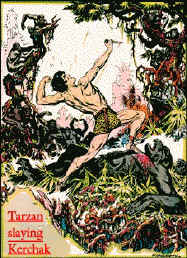 reasonable
adaptation of the first novel. But Hollywood soon strayed from Edgar
Rice Burroughs's conception of the Ape-Man and he very soon evolved into
an all-round good guy where Johnny Weissmuller dispensed justice to
wrongdoers in a sort of Jungle Book land while living in a tree-house in
the jungle version of suburbia. He was pals with all the natives and all
the cute animals and occasionally rolled over and over with the same
crocodile in every film. Edgar Rice Burroughs's Tarzan was a million
miles away from his screen portrayals ----he was as wild as the apes who
brought him up and fought and lived as one of them. Far from
having a faithful band of Waziri on permanent standby Tarzan's idea of fun
was to sneak into the native villages in the middle of the night and
after slaying as many of the blacks as he could, would mount their heads on poles for
the tribe to awaken to. The animals he came across were never cute ---he
ate most of them --and all in all he was a creature to be feared as much
as the tribe of mythical apes that brought him up. reasonable
adaptation of the first novel. But Hollywood soon strayed from Edgar
Rice Burroughs's conception of the Ape-Man and he very soon evolved into
an all-round good guy where Johnny Weissmuller dispensed justice to
wrongdoers in a sort of Jungle Book land while living in a tree-house in
the jungle version of suburbia. He was pals with all the natives and all
the cute animals and occasionally rolled over and over with the same
crocodile in every film. Edgar Rice Burroughs's Tarzan was a million
miles away from his screen portrayals ----he was as wild as the apes who
brought him up and fought and lived as one of them. Far from
having a faithful band of Waziri on permanent standby Tarzan's idea of fun
was to sneak into the native villages in the middle of the night and
after slaying as many of the blacks as he could, would mount their heads on poles for
the tribe to awaken to. The animals he came across were never cute ---he
ate most of them --and all in all he was a creature to be feared as much
as the tribe of mythical apes that brought him up.
It wasn't until 1984 that Hugh Hudson bravely reverted to the original
story with the grand title of Greystoke
: The Legend of
Tarzan,
Lord of the Apes
choosing for his leading man the virtually unknown Christopher Lambert
who has done nothing as good before or since. Tarzan of the Apes is
essentially a Victorian melodrama and the choice of Lambert as an
English aristocrat turned out to be inspired. His glowering visage when
angered contrasts with his little-boy- lost to perfection and Andie
McDowell as Jane has no difficulty in falling for his charms. There is
very little of the by now hackneyed battle with a crocodile or lion or
whatever ---the film concentrates more on Tarzan's rehabilitation into
civilisation and his reaction to the manner in which his erstwhile
family of apes are held in captivity.
There are some outstanding cameo performances and some memorable scenes
: Ralph Richardson as Greystoke's grandfather is excellent in particular
in the dining table scene while Ian Holm brings his own brand of acting
to the role of  Capitaine Phillippe
D'Arnot. One of the tensest scenes in
the film is when D'Arnot is being chased by savages and is suppressing whimpers of pain as he lies wounded in the crook of a tree while
they search for him below. It has to be said that the tribe of apes
leave a little to be desired in the way of authenticity but all in all
Greystoke
is a far more faithful and accurate rendition of Burrough's
creation that has gone before. The definitive Tarzan remains to be made
but Hudson has gone far in showing the way and has made the most
faithful version of the story to date. Capitaine Phillippe
D'Arnot. One of the tensest scenes in
the film is when D'Arnot is being chased by savages and is suppressing whimpers of pain as he lies wounded in the crook of a tree while
they search for him below. It has to be said that the tribe of apes
leave a little to be desired in the way of authenticity but all in all
Greystoke
is a far more faithful and accurate rendition of Burrough's
creation that has gone before. The definitive Tarzan remains to be made
but Hudson has gone far in showing the way and has made the most
faithful version of the story to date.
Strangely, since
Greystoke, Tarzan as a character has gone into decline
and not just on film but in the medium of comics which is sad because he
inspired dozens of top class artists to produce some beautiful work over
the years. Burne Hogarth was the finest of them all and his work has
been copied over and over again by various artists but never to the same
quality. Hogarth captured the essence of Burroughs's Tarzan to
perfection and again it is a mystery why his art is passing into
obscurity, sought after only by a small minority of fans.
Tarzan is one of the great icons of western popular art and has endured
for nearly a century and there's little doubt that he's out there now in
some primeval jungle stacking up a whole heap of new adventures for a
brand new audience. It is inconceivable that he never returns.
Jean de Florette {
1986 }
Manon des Sources { 1986 }
Director : Claude Berri
From the novel by Marcel Pagnol
Don't be put off by the French
sub-titles --- even the average Frenchman would be hard put to follow
the Provençal argot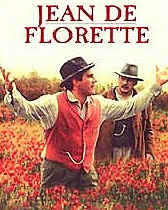 throughout the film. Marcel Pagnol was born and bred in Provence and
his intimate portrayal of the glorious countryside and its
inhabitants, written in 1963, has been turned into a delightful and
moving film. The two titles are deceptive as they are one and the same
film and do not stand alone.
throughout the film. Marcel Pagnol was born and bred in Provence and
his intimate portrayal of the glorious countryside and its
inhabitants, written in 1963, has been turned into a delightful and
moving film. The two titles are deceptive as they are one and the same
film and do not stand alone.
The Mediterranean sunshine and the famous flowers and herbs of the
Provençal countryside are pervasive throughout just as the
undercurrents of envy and covetousness from the locals are also
pervasive when Jean de Florette and his family arrive. Jean de
Florette played by Gerard Depardieu is big and jolly and the head of
his tiny clan consisting of his wife and daughter. He has arrived to
claim his inheritance consisting of a run-down farm and the land that
goes with it and his enthusiasm and indefatigable spirit in working
his land begin to produce results within a very short time. The locals
who have remained hostile are not impressed and de Florette's industry
and the results it brings only serve to inspire even more jealousy and
envy. Once the pin-up of French teenagers, an aged Yves Montand plays
Le Papet who is the malevolent instigator of an increasingly vicious
campaign to bring about the downfall of de Florette.
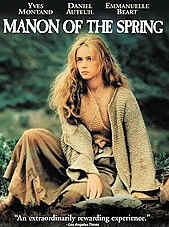 The
contrast between the happiness and simple joie de vivre of the
Florette's and the meanness of spirit of Le Papet could not be more
explicit but there is no warning of the shock ending that concludes
Jean de Florette. The
contrast between the happiness and simple joie de vivre of the
Florette's and the meanness of spirit of Le Papet could not be more
explicit but there is no warning of the shock ending that concludes
Jean de Florette.
The focus of the second film is upon the daughter of de Florette named
Manon, played by Emmanuelle Béart, who has the same stubborn defiance
as her father. The Provençal countryside is even more of a feature in
this film and introduces many more of the picaresque villagers as
Manon, now a shepherdess, spends her days in the hills among the
animals and flowers.
The easy-going style of the film is in keeping with the unhurried way
of life of the land but despite its length it is never dull and has
some surprising twists and turns in the plot. The most surprising is
in the very last reel which in one scene strips bare the venality of
human nature in the face of God's nature and the heavy penalty it can
exact and in its way is just as shocking as the ending to the first
film.
Apologies for the less than explicit description of the proceedings
but it would never do to give away the plot of this fine film.
Yves Montand has matured like fine wine and his tour-de-force
performance is particularly poignant because his wife was dying as he
filmed. Once the golden couple of the French film world, Montand and
his wife, Simone Signoret were at the pinnacle of their success
throughout the 50's, 60's and 70's. She passed away as the film ended
and the stunningly beautiful Simone Signoret's grave can be seen in
Pere Lachaise beneath a weeping birch.
Someone
to Watch Over Me {
1987 }
Director : Ridley Scott
Ridley Scott's first foray into
neo-noir has gone largely unnoticed but there's a lot to like about
this subtle, stylish and sexy film.
While Tom Berenger can be described as a movie star he has never truly
entered into the " household name" category which is strange
because he has all the attributes to be right at the top. In this film
he plays New York detective Mike Keegan assigned to guard Claire from
an assassin. Their social and topographical backgrounds are at
opposite ends of the spectrum ---she is a classy, upper Manhattan
socialite living in a luxurious apartment while Mike is struggling to
make ends meet in a less than salubrious area of Queens.
Claire is played by Mimi Rogers who is better known for being married
to Tom Cruise in a previous life but again her performance begs the
question why she is not far higher placed in the pantheon of Hollywood
beauties. In fact, this part is possibly the highlight of her career
and a tribute to Ridley Scott for bringing out the best in a very
neglected artist.
Thrown together for long periods, the inevitable happens and Mike
falls for Claire's charms which has a profound effect upon his home
life and in particular his street-wise wife, Ellie. Lorraine Bracco
plays Ellie in that remarkable mix of elfin-cute mixed with
wonderfully expressive facial expressions and the voice of a Brooklyn
stevedore.
Mike is bemused by contrasts that he has never before encountered and
moves from his merely functional home and the earthy mores of Ellie by
day to the swish and arty home of Claire and her seductive and
sophisticated allure by night --- and back again.
The contrasts are cleverly underlined by the background music ranging
from "Marie, Marie" by the Blasters as Ellie cleans the
windows to "Viens Mallina" and George Gershwin backgrounds
as Claire arranges her latest soirée.
You could do a lot worse than watch some great little performances on
a Winter's evening, cuddling up with a glass of wine while the wind is
howling and the rain is falling outside and Tom Berenger is coming
close to losing it all.
Revenge {
1990 }
Director; Tony Scott
From a short story by Jim Harrison.
Revenge,
the story, can be found in the same collection as
Legends
of the Fall. Unlike Legends,
there's no epic sweep in Revenge---
it is simply a chapter in the life of Jay Cochran { Kevin Costner }
---- it is nevertheless a traumatic and unforgettable chapter.
The film opens with Jay retiring from life as a fighter-pilot and
taking a sabbatical while he decides his future. At a time in the past
which is never defined Jay has saved the life of Tiburon 'Tibby'
Mendez in a way which is never recounted and he has been invited to
visit his home. The home turns out to be a palatial mansion set within
its own grounds and Tibby, played by Anthony Quinn is surrounded by
henchmen and bodyguards and obviously someone with connections.
Anthony Quinn plays the part of the urbane, charismatic and
sophisticated crime-boss to perfection and subtly lets us know that
beneath the mask lies a corrupt and controlling persona. All this is
of little importance to Jay until he begins an affair with the
voluptuous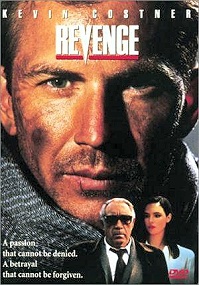 Mireya, the wife of Tibby.
Mireya, the wife of Tibby.
Mireya is played by Madeleine Stowe who manages to be seductive and
vulnerable at one and the same time. She is far younger than Tibby and
he has "acquired" her rather than courted her ---she is his
possession, a trophy wife. Nevertheless, he has a genuine affection
for her and she has learned acceptance until Jay comes along.
Jay and Mireya soon find each other's presence intoxicating and begin
to play a dangerous game in which they are soon discovered. The
consequences are far more devastating than either of them could
imagine. In Tibby's world the slightest word can be construed as an
insult and the greatest insult possible is to take another man's wife.
Where women are concerned the customs and passions of the Mexican
Tiberon Mendez are from the same code of honour of the Sicilian and
his vengeance is terrible and final. In a punishment straight from a
medieval courtroom, Tibby slashes Mireya's face from ear to ear and
sends her to a whorehouse for the rest of her days. Jay is assumed to
be dead.
Taken in by a Mexican family, Jay survives and begins his quest to
find Mireya and exact his Revenge in turn.
Tony Scott is the younger brother of Ridley Scott and has directed
among others, Days of
Thunder, Top-Gun, True Romance
and
The Fan.
Revenge is not nearly so
well known as any of them and didn't do well at the box office but it
is certainly up there with any of them for impact and entertainment
value. The beginning of the film as described above is quite
outstanding and extremely shocking with Kevin Costner, Anthony Quinn
and Madeleine Stowe outstanding together. It loses its way a little in
the middle as Jay searches for his lost love and comes together again
in a moving finale but overall Revenge
is a fine movie deserving to
far better known.
The Sheltering Sky {
1990 }
Director : Bernado
Bertolucci
From the novel by Paul Bowles
I don't as a rule watch
foreign films { ie; films in a language that is not English } because
much is lost in translation and 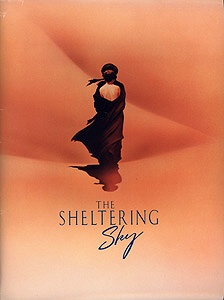 there
is sometimes an arty-farty feel about many of them. However, of the very
few that I have been impressed with The Sheltering Sky is high on the
list and has the added advantage of being filmed in English. there
is sometimes an arty-farty feel about many of them. However, of the very
few that I have been impressed with The Sheltering Sky is high on the
list and has the added advantage of being filmed in English.
To understand and appreciate the film it is helpful to know the
background of the author Paul Bowles who was born in Queens, New York
City, but spent 52 years in Morocco with his wife Jane, embracing
Moroccan culture and translating erstwhile unknown Moroccan authors into
English. He died in Tangier in 1999 in the small apartment that he had
lived in for years but his legend lives on among the Moroccan literati.
At the beginning of the film he can be seen sitting in the hotel foyer
on the Tangier waterfront as the passengers disembark ship and he can be
seen at the end in the same foyer ----- the once-proud waterfront hotel
can still be seen but is sadly dilapidated. For anyone wondering how the
great man could be seen in a film dated 2000 when he died a year
previously should note that 2000 is the release date.
Even knowing the background, Bertolucci's translation onto film is
difficult to comprehend but has obviously been made with loving care and
being open to several interpretations is not necessarily a bad thing
---at least it makes you think. Debra Winger and John Malkovitch are Kit
and Port Moresby arriving in Tangier circa 1940s, with a safari load of
luggage and no clear idea of where they are going or what they are doing
and there is a definite touch of Fitzgerald and Zelda about their
relationship. Bowles looks up from his newspaper with a jaundiced eye and a
sardonic smile.
Finding themselves in a dusty, louche and potentially dangerous African
city holds no fears for either of them as they seem oblivious to their
surroundings as they live in the luxury hotel and for me this is the
whole point of the film --- that they have no conception that there are
cultures which are totally alien to their way of life, something which
has been levelled at Americans abroad for generations.
Bored with Tangier and bored with each other they head out into the
desert with all the preparation you might take for a walk to the park
and find themselves in the hinterland where to their credit they begin
to enjoy the magnificent scenery. They also begin to enjoy each other
once again and the mood becomes quite erotic but it's all done in the
best possible taste. They seem to have little concept of danger which is
reinforced by their meeting with the eccentric Mrs Lyle and her son Eric
Lyle played by the magnificently off-the-wall Jill Bennett and the
equally magnificently dotty Tim Spall. The inference is that if these
two can enjoy afternoon tea and croquet in the sand then the Moresbys
can do the same but what they have failed to realize is that generations
of English aristos have survived in every country on the planet in this
tin-pot way ---their very strangeness an amulet against danger.
Enamoured of the country, the Moresbys reach the back of beyond where
life is harsh and they reach their very own heart of darkness when Port
succumbs to typhoid fever and eventually dies. It is only then that it
comes home to Kit that they are strangers in a strange land and have
paid a heavy price for their ignorance and detachment.
For what its worth, that is my interpretation of this noteworthy movie
but I could be totally wrong and there could be some explanation
involving metaphorical or allegorical themes that I have missed totally.
Even so, the photography is superb and it's always handy to be able to
ask the question "what did you think of Bertolucci's interpretation
of Bowles?" at a dinner party or even better walking home after a
bag of chips and 12 pints of lager.
Black
Robe { 1991 }
Director : Bruce Beresford
On the shores
of Georgian Bay, Canada, there is an accurate reconstruction of one of
the many Huron villages that existed in this area not too many years
ago. No Disney-like Indian village this ----it is a carefully
excavated archaeological dig which has unearthed long-houses,
palisades, artefacts and a tiny church with the whole site having the
wonderfully evocative title of
Saint-Marie Among The Hurons.
Champlain
passed this way in 1715, closely followed by a Jesuit mission
consisting of six missionaries stationed within the village with the
other two brave souls spreading the gospel out in the wilderness. The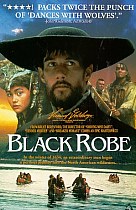 Huron called them Black Robes.
Huron called them Black Robes.
The native Indians of Canada were every bit as fierce as their
counterparts in America and perhaps more so, but the Huron accepted
the Black Robes with good humour and but for their help the
missionaries would have perished in the killing Canadian winters. It
might have been as well if they had all died given the fate that was
in store for them all when the implacable and bloodthirsty Iroquois
came calling. Caught up in a savage conflict between the two nations,
the Blackrobes were all captured by the Iroquois and subjected to the
most appalling tortures before being burnt at the stake - a fate once
reserved for heretics, the irony was lost on the savages.
The martyrs of the wilderness suffered just as much as the early
Christians and all have been canonized in recent years ---- their
shrine can be seen at the church and stations of the cross just
outside the gates of Saint-Marie.
For some reason, the custodians of Saint-Marie deny that
Black
Robe the
film has any connection to the village they administer but the
similarities are inescapable.
The film, set in the same era as the Jesuits, shows clearly the struggle
to survive the winter and is not slow to demonstrate the callous and
casual cruelty of the Indians whether they are Huron, Algonquin or
Iroquois. Lothaire Blutheau, fresh from his success in The Jesus of
Montreal plays Father Laforgue who is travelling from Quebec to the
Huron villages. The hardships of the wilderness are countered by the
courage and faith of the Black Robes in their desire to convert the
savages but Laforgue has an even greater struggle when he discovers
that the Huron have a religion of their own based upon dreams and the
world of night.
Bruce Beresford in a complete departure from Driving Miss Daisy
has
directed an historically correct adventure using a wholly
French-Canadian cast which is almost in the category of being a
documentary.
English wrestling enthusiasts of 50's and 60's vintage would sit up at
one name in the cast list --- that of Billy Two Rivers. Largely
forgotten except for an older generation of wrestling fans it's difficult
to describe just how popular Billy was at that time even though every
bout followed the same format ; Billy would get a hiding for 3 rounds
and then just when he was about finished he would summon up his last
reserves of strength and following a war-dance with his Mohawk haircut
standing proud he would demolish his opponent with his famous "tomahawk
chop" - nice to see then and nice to see now.
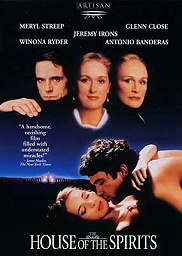
The House of The Spirits
{ 1993 }
Director : Bille August
The House of The Spirits
is an epic story set in South America
spanning the years between the 1930's and the 1980's and relating the
fortunes of the Trueba family ---a sort of
Forsyte Saga South American
style. The novel is far better known than the film which has vanished
without trace and seems to be valued only by Isabel Allende fans which
is a little strange because it has a cast to die for ---- Meryl Streep
as the ethereal Clara del Valle Trueba, Glenn Close, Winona Ryder,
Antonia Banderas, Vanessa Redgrave and Jeremy Irons riding rough-shod
over them all.
The story itself is of course long and complex but the scenes where
the spirits appear to Clara but to nobody else are truly hair-raising.
If you are into family sagas then you could do far worse than this
very watchable picture.
This Boy's Life
{ 1993 }
Director : Michael Caton-Jones
From the autobiography by
Tobias Wolff
This Boy's Life
passed unnoticed and unheralded when it was released and is quietly
fading into obscurity which is a shame as it contains among other
things another facet of Robert de Niro's acting skills. Perhaps the
inauspicious title has held it back ----
The Shawshank Inheritance
hung around for years until word of mouth recommendations by film
buffs turned it 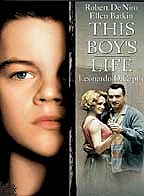 around
---- but whatever the reason it deserves a better fate. around
---- but whatever the reason it deserves a better fate.
Tobias Wolff's account of his unhappy adolescence, growing up in the
1950's is related and acted by a 12 year old Leonardo di Caprio who
has never done anything better to date. Toby's life consists of being
dragged all over the country on one Greyhound bus after another as his
feckless mother Caroline { Ellen Barkin } makes her escape from a
string of disastrous relationships. She attracts the worst kind of
no-hopers and losers but goes ahead and plunges straight into another
relationship almost as soon as she descends from the bus in the town
of Concrete which is as mundane as its name. On the surface, Dwight {
Robert de Niro } is an amiable dork, all goodwill and bonhomie,
declaring Concrete to be a lovely little town and believing that an
adroit flip of his zippo is a sophisticated and enviable social asset.
As their relationship develops, Dwight's true nature emerges slowly as
he turns from small-minded petulance into overbearing and dictatorial.
In a desperate attempt for some stability in her life Caroline marries
him and from that time onward he directs his vindictive and spiteful
nature upon Toby whenever the occasion arises. His own three cowed and
repressed offspring live for the day when they can leave the family
home.
The character of Dwight begins to dominate the film just as he
dominates Toby and he delights in humiliating the vulnerable boy every
chance that he gets. De Niro appears to have borrowed from Captain
Queeg on one occasion when he counts the chocolates in a jar and
discusses in depth the amount of mayonnaise left. His neurotic
obsession with trivia is bad enough but his dislike of Toby turns
violent and he imposes his will with increasingly harder blows.
There is one tragic/comic scene where the whole family are restraining
from laughing out loud as Dwight plays the sax and another where a
clip of the Cheryl Turner /Johnny Stompanato trial is on TV and Dwight
and Toby look at one another meaningfully.
Needless to say, Toby is a very unhappy child and seeks solace among
the town no-marks but his real outlet is his friendship with the
homosexual Arthur Gayle.
Arthur is played by Jonah Blechman and he is quite brilliant in his
role of the mincing Arthur, slowly and painfully coming to terms with
his sexuality -----to be the only gay in Concrete is not an enviable
situation. As Arthur, Blechman manages to convey the joyfulness of
youth and the sensitivity of an intelligent youth awakening to life's
harsh realities --- Arthur is not in many scenes but he manages to
steal every one.
Toby and Caroline eventually realise that escape is the only answer
and as they once again run away Dwight's whole self-pitying persona is
illustrated by his final words
"What about me" ?
ringing in
their ears.
Tobias Wolff had a traumatic childhood to be sure but he can take
consolation in the fact that out of it has come a great read and a
great film which could be some comfort to some other kid out there
living with a Dwight.
Once
Were Warriors { 1994 }
Director : Lee Tamahori
Powerful,
violent and hard-hitting are hardly expressions that are usually
associated with the peaceful islands of New Zealand but they are
fitting descriptions of one of the very few memorable films to come
out of those islands.
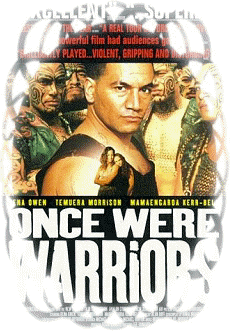 Jake
Heke dominates the film with his muscular and menacing presence in
just the same way as he dominates his fearful wife and family.
Sometimes charming, sometimes maudlin, sometimes ingratiating but more
often vicious and sadistic, Jake's bouts of drunkenness and violence
become more and more frequent as he thrashes about trying to find some
meaning to his life. There is a great deal of irony in the fact that
unemployed, drunk and a wife-beater he persists in trying to instill
what he perceives to be worthwhile values into his long-suffering
children. Jake
Heke dominates the film with his muscular and menacing presence in
just the same way as he dominates his fearful wife and family.
Sometimes charming, sometimes maudlin, sometimes ingratiating but more
often vicious and sadistic, Jake's bouts of drunkenness and violence
become more and more frequent as he thrashes about trying to find some
meaning to his life. There is a great deal of irony in the fact that
unemployed, drunk and a wife-beater he persists in trying to instill
what he perceives to be worthwhile values into his long-suffering
children.
Whilst there is no excuse for Jake's behaviour which ultimately leads
to his downfall the film is at the same time a parable of the plight
of the Maori nation and its loss of identity in the modern world.
Ethnic minorities all over the globe, from Native Americans to Zulu
warriors will empathise with the Maori people depicted in this film
and the similarities between nations overtaken by colonialism is
striking.
Therefore, the film works on two levels and is a serious study of loss
of national identity and its effect upon indigenous peoples. The
peaceful image of New Zealand today hides the fact that the Maoris
were an extremely proud and warlike nation and their wars with British
colonists were bloody affairs with no quarter given or taken ---take a
look at the Haka for some idea of how a Maori warrior went into
battle. Jake's fighting spirit and combative
nature is derivative of this era and the bar-room battles are
wincingly graphic. The domestic violence also pulls no punches and
although we may understand Jake's problem it is difficult to
sympathise with a man who has everyone living in the shadow of his
violent
eruptions.
Jake is not the man you want to pick a fight with in a bar and Temeura
Morrison's plays him to perfection while Rena Owen is also superb as
his long-suffering wife, Beth. The film is not for the squeamish but
certainly paints a graphic picture of the underbelly of New Zealand
society and is an introduction to a whole cast of native Kiwis who
would be impressive in any company.
Legends
of the Fall {
1994 }
Director : Edward Zwick
From a novella by Jim Harrison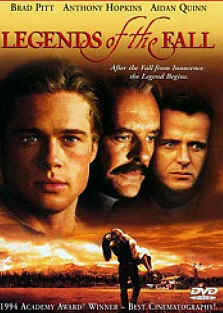
Legends of the
Fall is a Homeric saga of grand proportions set in Montana, spanning
the years from the 1880's to the 1860's. Epics such as these are
normally to be found bending the legs of coffee tables because their
massive bulk is too heavy to hold up in bed but Jim Harrison has
performed the incredible feat of condensing the whole story into a
novella. Director Edward Zwick has omitted nothing from the original
story but in fact has made several additions and alterations without
detracting from the source and has also performed wonders in fitting
the whole saga within the narrow parameters of a film.
It's the mark of a good film when the members of the supporting cast
are as memorable as the main stars and Zwick has taken Harrison's cast
of characters and carefully imbued their screen personas with a
singular personality of their own. Each of the players in the film is
as fascinating as the next in their own distinctive way -----from One
Stab { Gordon Tootoosis } the Cree Indian narrator to Pet Decker
played by Tantoo Cardinal { who can also be seen in Black Robe
} and
her husband played by Paul Desmond. Neither of the latter have many
lines in the film but both have that indefinable "presence"
which draws the eye to them whenever they are on screen. The O'Banions,
the Sheriff, the police officers and all the rest are brought to life
by Zwick's caring direction.
The focus of the film is the Ludlow family headed by Colonel Ludlow
{played by Anthony Hopkins with his usual careless brilliance } who has
tired of so-called civilization and has taken his three sons to live
in the wilds of Montana. Each of his offspring have distinctive
personalities, varying wildly from the idealistic Samuel { Henry Thomas
} to the pragmatic Alfred { Aidan Quinn } and onto the
wild and restless Tristan { Brad Pitt }. When Samuel brings home the
beautiful Susannah Fincannon { Julia Ormond } it would be traditional
to believe the time-worn cliché that she is the catalyst for all the
catastrophic events that follow and on the face of it there is some
truth in that. However, closer scrutiny reveals that most of the
happenings are triggered by Samuel himself who is instrumental in
leading his brothers into the horrors of the Great War in some vague
obsession about following in his father's martial footsteps.
Charged with looking after Samuel, Tristan is distraught when his
brother dies in a hail of bullets trapped on barbed wire. From then
on, Tristan is haunted with misplaced guilt and his behaviour becomes
even more erratic as he fights his demons. Susannah has demons of her
own to contend with as does Alfred and the death of Samuel has a
profound effect on the whole family splitting them all asunder and
scattering them to the four winds. The intricacies of the plot and the
fate of each of the characters are far too complex to relate here ----
suffice it to say that it is fascinating to discover just what happens
to each and every one of them and quite moving on occasions.
Although the twists and turns and nuances of the plot are diverse none
of it comes across as contrived and all of it is quite credible.
Beginning at a leisurely pace, the intricate and subtle plot is never
dull or slow and as it goes along it gathers speed accordingly until
in the final thirty minutes it is travelling like an express train. In
fact the finale of this film is one of the finest that I can recall,
bringing together all the loose ends in an explosive and surprising
finish.
One of my all-time great movies ---- understated and underrated. A
family saga of the old school which avoids all the melodramatic traps
of the genre.
The Shawshank
Redemption
{ 1994 }
Director : Frank Darabont
It's difficult to b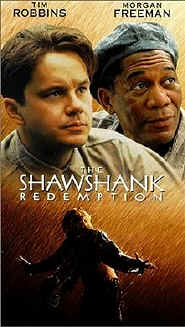 elieve
that a film with such excellent credentials would ever make it into the
"Lost and Found" section but that's exactly what happened
to The Shawshank
Redemption. It was off the radar for several years
simply because the title is less than inspirational and even now there
are people out there who are missing out for that very reason ---if you
didn't know and there was a choice between Shawshank and
Mission
Impossible et al which would you go and see ? And so, for a long time
the film was watched by a few of the more discerning film fans only and
knowing quality when they saw it a sort of cult status began to arise at
one time. Since then, word of mouth recommendations have ensured that
Shawshank has entered the mainstream and it is slowly
but surely coming to be seen as one of the finest films of all time. elieve
that a film with such excellent credentials would ever make it into the
"Lost and Found" section but that's exactly what happened
to The Shawshank
Redemption. It was off the radar for several years
simply because the title is less than inspirational and even now there
are people out there who are missing out for that very reason ---if you
didn't know and there was a choice between Shawshank and
Mission
Impossible et al which would you go and see ? And so, for a long time
the film was watched by a few of the more discerning film fans only and
knowing quality when they saw it a sort of cult status began to arise at
one time. Since then, word of mouth recommendations have ensured that
Shawshank has entered the mainstream and it is slowly
but surely coming to be seen as one of the finest films of all time.
There is an elusive "je ne sais pas" quality to Shawshank and
anyone who is asked what they think of it invariably breaks into a grin
and a nod of appreciation.
Frank Darabont has made a delightful movie from that rarity which is a
Stephen King short story minus any horror connotations with the
intriguing title of Rita Hayworth
and The Shawshank
Redemption. Stephen
King is a master storyteller and Darabont has retained that intimacy
between audience and cast by using Morgan Freeman's rich baritone to
relate the story as he sees it. The old con { Red Redding }
personalises the story to such an extent that it is as if he is speaking
directly to each member of the audience and the effect is enthralling.
Tim Robbins invariably
chooses parts which are intelligent and unusual but he will wait a long
time before another Andy Dufresne comes along. Likeable and easy-going,
Andy is as vulnerable as you and I would be in a tough prison yard but
to the wonderment of Red he exhibits talent after talent for survival
which finally leads them both to freedom.
An understated masterpiece of film making ---watch
the film, read the
story.
The Bridges of
Madison County
{ 1995 }
Director : Clint Eastwood
From the novel by Robert James Waller
There's no action, there's no bad guys to shoot at and it's set mostly
within the confines of an Iowa farmhouse and as it is first and
foremost a love story I would say that this is a "woman's
film"and not for me and I suspect that this is why it never took
off at the box office. However, in an idle moment I had read a
compilation of short stories by the author and found them to be
outstandingly well written and extremely moving. Robert. J.Waller has
the disconcerting habit of writing beautiful prose and giving it such
mediocre titles that it is a wonder he has sold any books at all.
Puerto Vallarta Squeeze, Old Songs in a New
Café,
Border Music are
hardly inspirational but they are all excellent reading and Slow Waltz
in Cedar Bend is a hauntingly beautiful love story set in America and
India. The Bridges of Madison County hardly set the cash boxes
jangling on its release but it is in fact one of Clint Eastwood's
finest films, stating eloquently that he has become an actor and
director of many talents.
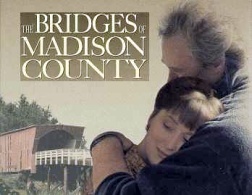 Ostensibly,
the film is simply a three day love affair between an itinerant
photographer and a bored housewife but in reality it is about
unfulfilled dreams and lives unlived. Francesca Johnson { Meryl Streep
} has met an American soldier during the war in her native Italy and
like so many G.I. brides her romantic images of life in America have
been shattered ; she lives in an isolated farmhouse with her teenage
children and adoring husband and although she loves them all, her
triumph and her tragedy are that she is extremely intelligent and has
the soul of a poet with no way to fulfil her potential. Women
everywhere will identify with Francesca as she puts her families needs
before her own. On the other hand, Robert Kincaid Ostensibly,
the film is simply a three day love affair between an itinerant
photographer and a bored housewife but in reality it is about
unfulfilled dreams and lives unlived. Francesca Johnson { Meryl Streep
} has met an American soldier during the war in her native Italy and
like so many G.I. brides her romantic images of life in America have
been shattered ; she lives in an isolated farmhouse with her teenage
children and adoring husband and although she loves them all, her
triumph and her tragedy are that she is extremely intelligent and has
the soul of a poet with no way to fulfil her potential. Women
everywhere will identify with Francesca as she puts her families needs
before her own. On the other hand, Robert Kincaid
{ Clint Eastwood }
is a well-travelled man of the world ----on the surface
self-sufficient and needing nobody, but underneath is more vulnerable
and fragile than his appearance will allow ; his romantic life-style
is missing the one thing that Francesca has ---the stability of a
loving wife.
The pair of them complement each other and the chemistry between them
is palpable ; in fact the first stumbling steps they take on the way
to an affair are far more erotic than all the naked romps which seem
to be obligatory these days. There are scenes at the beginning and end
of the film where Francesca's son and daughter pore over her diaries
and her love affair which comes as a revelation to them both.
Surprisingly, these portions of the film are quite mediocre and can
only be attributed to the lack of charisma by the actors involved but
they do serve the purpose of highlighting just how good Clint Eastwood
and Meryl Streep really are in their roles.
When Francesca sees Robert for the last time as she glimpses him dimly
through a torrential rainfall it is an extremely moving finale to an
old-fashioned and unashamed weepie, as they reluctantly sacrifice their mutual love.
House of
Sand and Fog
{ 2003 }
Director : Vadim Perelman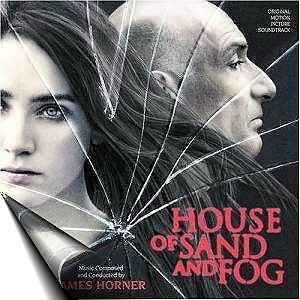
Novel by Andre Dubus 111
Has largely passed unnoticed by the average cinemagoer who is missing
an excellent film which is unusual in the very ordinariness of its
suburban setting and the absence of psychos, weirdos or gunplay. The
film revolves around something as mundane as the purchase of a house
on the California coastline and slowly evolves into a Kafkaesque web
of council bureaucracy and red-tape which escalates into tragedy
beyond all proportion for the parties involved. In many ways stories
such as this are far more chilling than all the bloody knives and
hoary skeletons of the traditional horror tale and the reason is
simply because any of us could be caught up in such events and
therefore identify strongly with the characters. In fact there are few
of us lucky to have escaped some sort of bureaucratic tangles but for
those who have been involved it can be extremely stressful so the
nightmarish situation that Kathy { Jennifer Connelly } finds herself
in expanded to nightmarish proportions is very identifiable. Sir Ben
Kingsley as he will readily tell you is excellent in the part of
Colonel Behrani caught up in the ever-escalating conflict with Kathy
which eventually leads to unforeseen tragedy for all of them.
Black Rain {
1989 }
Director; Ridley Scott
The sun never shines in a Ridley Scott movie;
everything is played out in a claustrophobic smog of apocalyptic
landscapes, no matter if they are on earth or in outer space.
Bladerunner's Decker would be quite at home in Scott's Osaka of
rain-mist and gloaming and smoke from street vents, where the only
lights are neon or strobe and even Ripley would find little difference
from the Alien planet of stygian gloom. By replicating those same
landscapes, Scott has cleverly made 1980's Osaka just as alien to New
York cops, Conklin and Vincent { Michael Douglas and Andy Garcia
respectively } ------ they are without doubt, strangers in a strange
land.
The setting is everything to this film ---- it is an omnipresent
backdrop of looming disaster, sinister forces and unseen menace where
lorries and cars take on a futuristic aspect and the action takes place
amid a forbidding jumble of concrete and steel. The final scenes
in the steelworks are as satanic and scary as the corridors of the
Nostromo and Scott's world is one 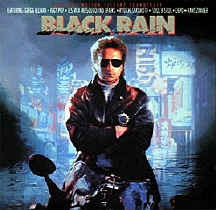 where our man-made landscapes appear
to function without human aid and have taken on a life of their own. where our man-made landscapes appear
to function without human aid and have taken on a life of their own.
Take away the backdrop and you have a good action movie ------ add
the atmospheric surrounds and you have a superb film -noir with Ridley
Scott's unique style stamped indelibly all over it.
As for the acting, Michael Douglas's flawed cop is riveting
----never more so than when he is interacting with Ken Takakura's staid
Japanese detective. Andy Garcia seems destined to play sidekicks
all his career ---the penalty for his youthful good looks perhaps
? He never really made it beyond playing second string which is a
shame because Garcia has real screen presence and it is also a mystery
because there has never been any shortage of gangster movies in which he
would have excelled.
All in all, Ridley Scott with Black Rain, takes the cop genre to a
higher plane and a different place --brilliant!
I
recently bought Black Rain for 50p in a car-boot and is an example
of a movie I had seen but never appreciated just how good it was or just
how good a Director Ridley Scott could be.
And
so it goes on, with so called "blockbusters" making millions
and worthier films ending up unknown and unheralded. An excellent
example is a Bruce Willis epic involving itself in the ethnic cleansing
in Rwanda where Bruce leads a gung ho band of soldiers on a march to
save a number of refugees. There are bullets flying everywhere and
selfless heroism and so on ad infinitum---in fact it is so memorable
that I can't even remember the name. A much less obtrusive film is the
thoughtful and thought provoking Hotel
Rwanda which is occupied with the same subject but in a
much more intelligent manner. There is very little action but
there is an element of fear engendered throughout the film more by the
implied violence than the overt. But how many people going to a
multiplex would choose the latter against the former ?

 Sign
the Guestbook and comments please. Sign
the Guestbook and comments please.
If you liked this Web site then I have four
others on the Web which are different subjects but built to the same
format with plenty of graphics and a down-to-earth approach to each
subject. The first is about the City
of Paris, the second is Cities of
Europe, the third is a biography of
Suleiman the Magnificent
and lastly the shipwreck of the Medusa.
If you like colourful sites which are informative but informal
then you could do a lot worse.
worse.
www.geocities.com/rezdechausee www.geocities.com/parivision2000 www.geocities.com/mast2don www.geocities.com/stomataus
|



